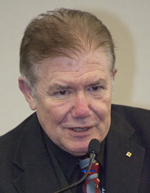 |
Gérard-André CapolinoUniversity of Picardie “Jules Verne”, Amiens, France
|
Gérard-André Capolino (A’77–M’82–SM’89–F’02) was born in Marseille, France. He received the B.Sc. degree in electrical engineering from the Ecole Centrale de Marseille (ECM), Marseille in 1974, the M.Sc. degree from the Ecole Supérieure d’Electricité (Supelec), Paris, France, in 1975, the Ph.D. degree from the Aix-Marseille University (AUM), Marseille, in 1978, and the D.Sc. degree from the Institut Polytechnique de Grenoble (Grenoble INP), Grenoble, France, in 1987. He had several faculty positions in Yaoundé, Cameroun, Le Creusot, France and Marseille, France. In 1994, he joined the University of Picardie “Jules Verne,” Amiens, France, as a Full Professor and was appointed Chair Professor in 2013. Since 1975, he has published more than 450 papers in scientific journals and conference Proceedings. He has been the principal investigator for more than 50 research contracts.
Dr. Capolino is an Associate Editor of the IEEE TRANSACTIONS ON POWER ELECTRONICS, of the IEEE TRANSACTIONS ON INDUSTRIAL ELECTRONICS and of the IEEE ACCESS. He is also the acting Chair for the Steering Committee of the International Conference on Electrical Machines (ICEM). During 2012–2013, he was the President of the IEEE Industrial Electronics Society (IES). He is also a distinguished lecturer of IEEE-IES. He has been the recipient of the 2008 IEEE-IES Dr.-Ing. Eugene Mittelmann Achievement Award, the 2010 ICEM Arthur Ellison Achievement Award, and the 2011 IEEE-PELS Diagnostics Achievement Award.
Future Ttrends in Electrical Machines Technology
The principle of electrical machines has been
known for at least 500 years with the first electrostatic machines invented
around 1600. The first electromagnetic machines have been imagined later in
the 17th century after the discovery of the electromagnetism
principle. However, it has been necessary to wait up to the end of the 19th
century to have rotating electrical machines structures close to what they
are nowadays. Basically, the presentation starts from classical electrical
machines which can be manufactured by using steel, copper and sometime
aluminum with other insulating materials and parts which are used for the
assembly (case, shaft, bearings, fan and more). Then, the presentation moves
towards future trends based on high efficiency AC electrical machines,
nano-actuators, very high speeds and very low speeds motors/generators and
special electrical machines for embedded systems and emergency applications.